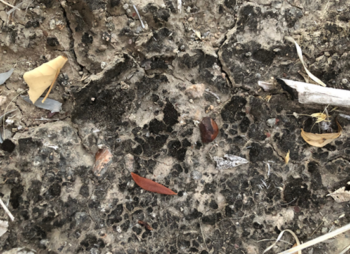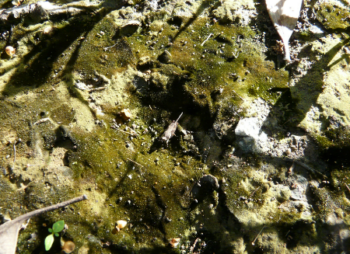New Biocrust project – Boosting natural regeneration of nitrogen in grazing lands
Researchers at the University of Queensland are investigating how fire and grazing can be managed to optimise nitrogen inputs by biocrusts to improve the productivity of grazing lands in northern Australia. Funded by Meat and Livestock Australia, biocrusts are being put through their paces at the Kidman Springs fire experiment 400 km south of Darwin (Northern Territory Department of Industry, Tourism and Trade) and the Wambiana grazing trial in north Queensland (Queensland Department of Agriculture and Fisheries).
What are biocrusts?
Biocrusts are the ‘living skin’ on the surface of the soil. They are composed of lots of tiny organisms including cyanobacteria, fungi, green algae, bacteria, lichens, liverworts and mosses. They grow when it’s wet or dewy and become inactive when it’s dry, just like plants.
Why do we care about biocrusts?
- Biocrusts stabilise the soil surface – they intertwine with soil particles to bind them together, preventing erosion from wind and water.
- They photosynthesize and fix carbon – algae, cyanobacteria, lichens, liverworts and mosses are all green and photosynthesize just like plants. The carbon they pull out of the air is incorporated into the soil and enhances soil carbon.
- They fix nitrogen! – most cyanobacteria fix nitrogen out of the air just like legumes do! They use the nitrogen to grow, but store any excess nitrogen they fix in a slimy layer around their cells. When it rains, much of this plant-available nitrogen enters the surrounding soil and is available for pastures. In the dry season the biocrusts dry out and partly disintegrate. This nutrient-rich biocrust is incorporated into the soil as organic matter with early wet season rains. The amount of nitrogen that biocrusts fix every year is similar to the amount of nitrogen fixed by native legumes in our grassy tropical savannas.
Soil fertility is a major limitation to pasture growth in tropical savannas, but it doesn’t pay to add fertilisers at these extensive scales. We are testing if we can manage grazing and fire to maximise the natural carbon and nitrogen inputs by biocrusts into soils and enhance soil fertility and productivity in tropical savannas.
Where are biocrusts?
They are in the top 1-2 cm of the soil, usually covering the ‘bare’ ground spaces between plants. Biocrusts are found all over the world from freezing Iceland and Antartica to hot deserts and savannas. In tropical savannas biocrusts are dominated by cyanobacteria and liverworts.
What do they look like?
In Northern Australia biocrusts often appear as dark staining on the soil surface in the dry season (below left) and dark green slimy films during the wet season (below right).
 |  |
But wait, aren’t soil crusts a bad thing?
There are two types of soil crusts. Living biocrusts are distinct from dead physical crusts that form on degraded soils. Physical soil crusts can inhibit water infiltration and plant growth. Living biocrusts enhance soil moisture, soil fertility and plant growth.
What effect do fire and grazing have on biocrusts?
Fire can enhance biocrusts by removing litter, trees and shrubs that would otherwise compete as ground cover, yet you need the right amount of fire, not too much, not too little. Biocrusts in Australia’s tropical savannas, like our native vegetation, have evolved with fire and hence are well adapted to fire. Biocrusts from Kidman Springs regrew just as well after fire as unburnt sites. During the wet season burnt biocrusts on alluvial soils actually grew faster than unburnt biocrusts.
Grazing can also potentially open up spaces for biocrusts by reducing plant cover. Nevertheless, the trampling by hooved animals is not something Australian ecosystems have evolved with, so our biocrusts are quite susceptible to heavy trampling. At the Wambiana grazing trial near Charters Towers biocrust cover was higher and healthier with moderate grazing than with heavy grazing. Future work will examine what this means for nitrogen inputs.
If trampling is bad for biocrusts how can we manage grazing to benefit biocrusts?
During the dry season biocrusts dehydrate and become dormant. The carbon and nitrogen they fix is broken down and recycled by other critters in the biocrust, and then becomes incorporated into the soil and available to plants. We suspect that spelling over the wet season while biocrusts are actively growing, and grazing during the dry season when they are dormant, will benefit not only palatable plants, but also biocrusts, allowing them to maximise their growth and nitrogen fixation.
If you would like more information regarding the role of biocrusts in the Northern Territory rangelands, contact Dr Robyn Cowley, Senior Rangeland Scientist, on 0419 829 493.
Additional information about the Boosting natural regeneration of the nitrogen capital in grazing lands (Biocrusts project), contact Wendy Williams, the University of Queensland Project Manager, on 0418 246 001.